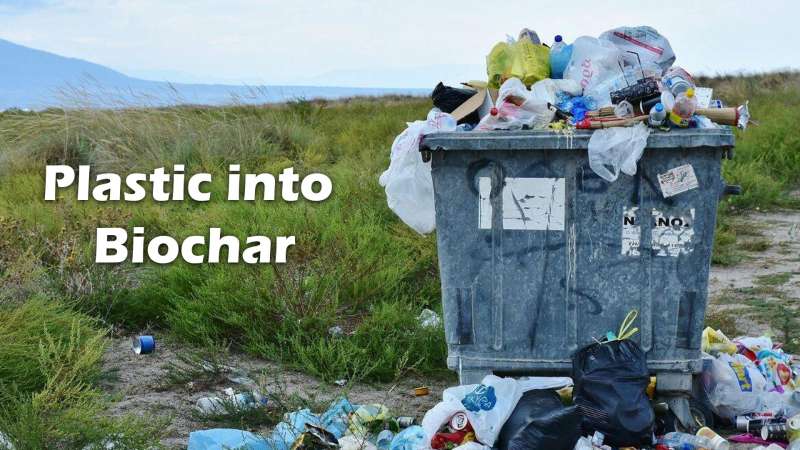

Innovation has no limits and this sentence is proved again the scientists at the University of California had accomplished something which is remarkable. All of us are familiar with the process of recycling plastic. But recycling all the produced plastic is not possible there are some forms of plastic that are not recyclable. But some people consider that recycling plastic might reduce its production but it does not solve the problem regarding the hazardous results of plastic usage. There are people who are working to convert this plastic into something useful in other forms. And that is the thing these engineers have done. They have developed a method that can be used to convert certain plastic materials into bio charcoal or biochar which can further be used as a soil substitute. The two forms of plastics we generally use in the manufacturing of plastic water bottles carry bags and insulation storage containers which are made using Styrofoam. These contain PET and polystyrene are used in this method. They were able to convert these two forms of plastics into biochar
What exactly is biochar, and how is it created?
By burning biomass without oxygen, a process known as pyrolysis, biochar is a sort of charcoal that is produced. The “bio” in biochar alludes to the fact that it is created using organic materials that are renewable, such as wood chips or agricultural waste.
Biochar, the end result, is a porous, carbon-rich substance that may be used to amend soil or filter water. Its huge surface area makes it good at adsorbing contaminants
and holding onto moisture. Additionally, biochar has a long shelf life, allowing for convenient storage and usage.
By supplying vital nutrients and enhancing soil structure when used as a soil supplement, biochar can enhance plant development. It may also support growth.
How can plastic be converted into biochar?
The process to convert the plastic into biochar begins with first breaking the plastic into small pieces and then mixing of two commonly used plastics, in this case, PET and polystyrene, with corn stover, which is basically a combination or mixture of leaves, husks, and cobs of corn. After mixing them together, the mixture is subjected to highly compressed hot water in a process where organic compounds are converted to structured carbons known as hydrothermal carbonization. The product formed, which is the biochar, is highly porous, and its magnitude is slightly higher than that of typical biochar.
What are the advantages of biochar?
The biochar produced which is highly porous could be added to soil to increase its water retention capability which is the measure of how much amount of water it can soil hold or absorb. It is even easily breakable so it can be used to fertilize the soil. Generally, plastic is made up of petroleum which is a non-renewable source that is high usage of these sources leads to their exploitation, whereas biochar produced here is from used plastic which is harmless. Biochar may be utilized in home gardens and for backyard composting in addition to its industrial purposes. It can assist enhance compost quality and minimize odor. Biochar is also being researched as a potential carbon sequestration method to aid in climate change mitigation. Carbon sequestration is a process that is used to trap the carbon dioxide inside the soil and this can reduce the amount of emitted carbon dioxide into the atmosphere which is also known as climate change mitigation.
An important study from this research?
The latest study expands on a previous one where the researchers created activated charcoal from maize stover that could filter impurities from drinking water. In the earlier investigation, it was discovered that activated charcoal manufactured from maize stover could remove 98% of the contaminant vanillin from test water samples.
The goal of the new follow-up investigation was to see whether waste plastic and maize stover might be mixed to produce a potent water treatment chemical. However,
after extracting activated charcoal from the mixture, they discovered that it was unsuccessful as a water treatment solution since it could only absorb roughly 45% of the contaminant vanillin from test water samples. However, according to research, the higher surface area of biochar compounds indicates that they can be used for a variety of purposes without being converted into activated carbon.
Of course, the method isn’t without flaws. Typical by-products of plastic-to-char products are classified as gaseous (carbon dioxide, methane, hydrogen, and light olefins) and condensable liquids (olefins, oligomers, and aromatics). The gaseous products are not potentially harmful, but they will increase carbon emissions. Condensable liquids, on the other hand, can be converted to fuels or chemical commodities.
Furthermore, the procedure requires high temperatures in order to break down the biomass and plastic. This implies that it requires a significant temperature input, making it less effective than traditional mechanical plastic recycling. But these can be avoided by finding alternate solutions or methods and currently the researchers are working on it.
Finally, we all know what it’s like to live in a world where the amount of plastic waste produced each year is rapidly increasing. Even in the deepest parts of the ocean plastic waste is found. Coming up with a solution that not only solves the problem of recycling plastic but also makes it into something useful is something we have seen today.
Researchers are working hard on improving the properties of the newly produced biochar so that the procedure can be used to create biochar from plastic and use it without any second thoughts. Research is underway to mix different variants of plastic to convert them into biochar, which can then be used. As mentioned, biochar even helps reduce the greenhouse effect by trapping carbon dioxide beneath the surface. Plastic has become an important part of modern life, but we can try to reduce our use of it by using alternatives to plastic. We need to make people aware of these new innovations which are helpful.


